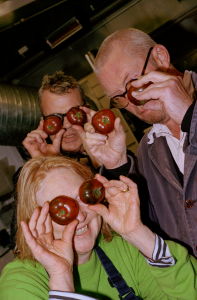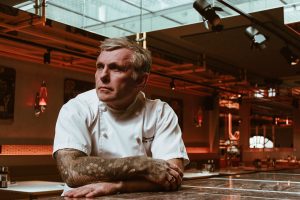The lauded chef discusses one of his flurry of recent openings, Kioku

When I arrive at Kioku by Endo at the OWO, I am early. To kill time, I decide to take the stairs, which does two things: allows me to observe the straight-backed Edwardian gentility of the Old War Office, all plush red carpets and gilt and gleaming marble; and makes me extremely out of breath; Kioku, it turns out, is at the very top, on the sixth floor. It’s good, then, that when you reach the restaurant, you can catch your breath on the roof terrace outside – and even better that the roof terrace overlooks most of central London, the view stretching over Horse Guards and Whitehall and into the dense, glossy green of St James’ Park. The restaurant even has a little turret, entirely separate from the main space, with 360-degree views over the city.
The food at Kioku mirrors this ebullient sweep, this bold expanse of rooftop and sky. It’s a confident marriage of Eastern and Western sensibilities – a synthesis that occurs not simply in presentation or ingredients, but in shared approaches. There’s a Mediterranean emphasis, for example, on the provenance and sourcing of fresh ingredients, which is paired with a typically Japanese eye for detail. Think Chashu pork ramen ravioli; or aged monkfish, smoked eel, potato rosti, watercress and ginger sauce.

The force behind the restaurant, Endo Kazutoshi is one of the most celebrated chefs working in the UK today. A third-generation sushi chef from Yokohama, he learnt the ropes both as an apprentice at an omakase restaurant in Tokyo and at his family’s restaurant, before leaving to work under Akitoshi Ohno, a renowned sushi master in Nagoya. After this, Endo worked in Madrid before coming to London, where he was selected to lead the sushi bar at Zuma and oversee eight international branches. After stints as a private chef, he opened Endo at The Rotunda in April 2019, which after less than a year earned both a Michelin star and the title of London’s hardest-to-obtain reservation. More recently, the chef opened another restaurant, NIJŪ. There, the food is inspired by Katei Ryori, or Japanese home cooking – if your parents happened to be sushi masters. These are classics done perfectly: diaphanous, nimbic shokupan; tuna tataki that almost dissolves on the tongue.
Can you talk a bit about how your background has influenced your work? You come from a long line of sushi masters, don’t you?
I was pretty much born in a sushi restaurant – my grandpa opened his in 1940. I started as a sushi chef around 30 years ago. I only worked with my father, who was a sushi chef as well, for seven months. But my education – my mental education as a sushi chef – began at five years old. And that was from my mother. She taught me everything: calligraphy, tea ceremony, how to engage with guests. So it’s from her that I was educated in the philosophy of being a chef.
Technique is easy; it’s the mindset that you have to learn – and it’s not easy. Now, Instagram and other social media make it easy to learn that kind of thing. But it’s so direct, there isn’t that wider knowledge. I started thirty years ago, so I didn’t have an iPhone. There were no diversions. To me, that’s why my generation is good – we had to learn everything the hard way.
You came to London in 2007 – how has the sushi scene changed since then?
In the last ten years it’s changed a lot. Many guests have a lot more knowledge in Japanese cuisine – there’s a lot more interest, and Japan’s become one of the top places to travel.
London is so cosmopolitan; it’s the centre of Europe for me. And there are a lot more Japanese restaurants here now – every month there’s a new opening. But now, a lot of them are similar. That’s why we need something unique.
What do you look for in a dish? What does a perfect plate mean to you?
For me, I need a story. I don’t want to just do any single dish ‘made nice’. For instance, you go to a gallery like Tate Modern, and you see these works – without the story behind them, they’re just pictures. But when they have that soul, that spirit, that’s what brings people to tears.
And on that note, are you inspired by art or culture when you cook?
A lot. I love Commes de Garçons. For me, it embodies this idea of challenging both tradition and innovation – asking what, exactly, is innovation? Not simply a twist, not fusion. I love punk music too. It’s revolution, it’s anarchy.
What was the purpose behind your new restaurants? Why do you think they’re needed?
For me, a lot of Japanese food in London is very same-y. That’s why I really want to do something more innovative, something different, in terms of concept. You know, in the beginning, everybody was looking to Zuma, everybody was copying Zuma. There’s a lot of the same stuff. I think there needs to be some kind of pioneering, some kind of option. There needs to be a different kind of Japanese restaurant. It’s always sashimi, sushi, omakase – I don’t do omakase, because everybody does it already! We need something different.
In Japan, you can get the best pizza, the best French food. It’s these cuisines put through a Japanese filter. It’s not a twist, it isn’t fusion – there’s no sashimi with truffle oil – but it’s taking these foods and adding my philosophy, my ‘filter’.

How does Kioku differ from NIJŪ and Endo at the Rotunda – how would you define and differentiate the spaces?
They’re all totally different spaces. Rotunda is just totally me, mine. This isn’t any filter. That’s why there are only ten seats. But at Kioku, there’s more of a sharing atmosphere. It’s more relaxed. And of course the food is different – at Kioku, it’s Mediterranean food, but through my filter. It’s entirely new.
NIJŪ is much more of a home-cooking vibe. It’s the kind of food that I want when I go home and ask my mum what we’re having for dinner that evening – except a bit more elevated, of course. It’s skewers, fried katsu. Whereas Kioku is entirely special occasion food.
The interior of Kioku is so beautiful – incredibly elegant and evocative. Can you talk me through the design?
At Kioku, my concept is my memory; it’s part of my philosophy. Actually, the reason why I chose to design the space in this way is because of a place in my hometown, Yokohama, called Hotel New Grand – they opened 160 years ago, or something. In the Edo period, 180 years or so ago, Japan was completely closed, and there was no trade with the outside world. The first open place was Yokohama – and even now it’s a really fast-paced, cosmopolitan place – and a lot of British people came there and made a lot of European-style buildings. And one of these was the Hotel New Grand, and it’s my mum’s favourite place. We’d always go for tea and cake there. That’s why I wanted the interior of Kioku to feel, not similar, but inspired by that place, by my memory of it. That’s why I chose this building; there’s a lot of history to it. I didn’t want somewhere that was just new.
What are your favourite restaurants in London?
Last December I went to Le Gavroche… it was so incredible, the most memorable experience, especially because it’s now closed. Also Ikokyi, with Jeremy Chan, who’s a friend of mine. To be honest, I tend to prefer a much more casual restaurant, often in East London, with natural wine. Of course, I’m looking for something new – that’s why I go – but now I want something a little more relaxed. Yesterday I went to Mountain, which was good, and has that kind of vibe.
What do you like to cook at home?
I never cook…. Cooking is not my hobby. Many chefs say ‘I love to cook!’. But for me, that’s my life; that’s my destiny. I draw a line between my work and my home life.
Kioku by Endo opens on 15th May.




